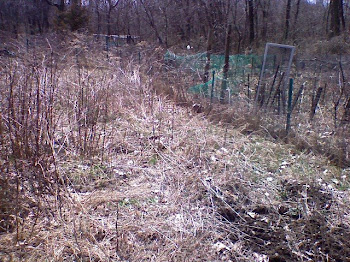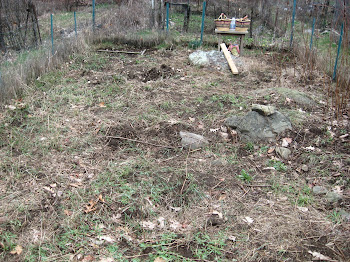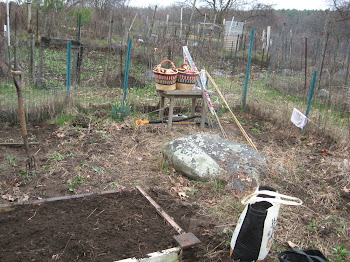
Thursday, January 27, 2011
Winter starters
Hopefully, at least. It's always a gamble starting seeds in January/February, but I like to do it. When I was at C-Mart in Chinatown last weekend, seeing these seed packages inspired me just a little. We'll see what happens.When I've done this in the past, I used those little fairy lights to supplement what light they got. It helps - but of course I need to choose my containers wisely too. I used containers last year that were much too small, and they dried out too quickly as a result. Poor little seedlings couldn't tolerate the conditions. This year, hoping to get the balance right...and maybe get a few edibles out of it too. I'm hoping to get an early start on those eggplants - but I'm also realistic about the fact that it's just too cold. On the other hand, the other two packets just might do alright. We'll see. Watch this space for updates, I guess.


Labels:
container gardening,
seed starting,
vegetables,
winter
Thursday, January 20, 2011
More White Fluffy Stuff, Anyone?
...followed by negative temperatures, according to the predictions I see. Whatever. Winter in New England. Moving right along!
That only makes me want to work on my soup recipes. I've been eating ratatouille lately, but I'm craving that staple of Vietnamese home food, curried chicken soup (Ca Ri Ga). I haven't quite got the spices to my liking yet, but I'm close. Also it has the advantage of being something I can cook in my fabulous, family-size rice-cooker. Although I love the thin, clear, angel-hair like mung bean noodles that are traditional with this, I find that detail too much of a hassle at home -- mostly because whenever I cook those noodles, I make a big hot splashy boiling-water mess. Rarely do I create true kitchen disasters, but for some reason, these noodles trigger the jinx! So, rice is my go-to happy substitution for soup. It works for me.
Another variation on the recipe is that I simply prefer my chunks of carrot & potato smaller. I realize you run the risk of the chunks falling apart, but I'm just fine with that risk; it will still taste good and will actually fit in my spoon this way (and that's keeping in mind I use a big spoon when eating this soup).
I'm thinking about cooking lamb soon, as well. Been a while since I've cooked lamb, so maybe a roast with lots of carrots and potatoes and parsnips. If it turns out photogenic as well as edible, I'll try to remember to post a recipe & a photo here.
And now, back to my garden catalogs...
- Posted from my iPhone...
That only makes me want to work on my soup recipes. I've been eating ratatouille lately, but I'm craving that staple of Vietnamese home food, curried chicken soup (Ca Ri Ga). I haven't quite got the spices to my liking yet, but I'm close. Also it has the advantage of being something I can cook in my fabulous, family-size rice-cooker. Although I love the thin, clear, angel-hair like mung bean noodles that are traditional with this, I find that detail too much of a hassle at home -- mostly because whenever I cook those noodles, I make a big hot splashy boiling-water mess. Rarely do I create true kitchen disasters, but for some reason, these noodles trigger the jinx! So, rice is my go-to happy substitution for soup. It works for me.
Another variation on the recipe is that I simply prefer my chunks of carrot & potato smaller. I realize you run the risk of the chunks falling apart, but I'm just fine with that risk; it will still taste good and will actually fit in my spoon this way (and that's keeping in mind I use a big spoon when eating this soup).
I'm thinking about cooking lamb soon, as well. Been a while since I've cooked lamb, so maybe a roast with lots of carrots and potatoes and parsnips. If it turns out photogenic as well as edible, I'll try to remember to post a recipe & a photo here.
And now, back to my garden catalogs...
- Posted from my iPhone...
Monday, January 17, 2011
Weather Fail
It vaguely amuses me when I check the weather site to see how far off their predictions can be. I don't expect a lot of accuracy; this is New England after all, land of random 70ºF days in January and freak snow squalls in August.
You would think, however, that they could decide what the current temperature is, right?
Not so much.
The various weather 'apps' and sites I check in with always cite a high & low temperature for the day. In theory, when the current temperature drops, so should that low, right? No.
Low tonight in the 20s? Uh, oops: it's currently 2ºF now, as the tightly curled tubes that my rhododendron leaves have become will confirm.
The take-home? It's still true that if you want to know what the weather in New England is, you're best off looking out your own window. Thanks Ben Franklin, whereever you are.
- Posted from my iPhone...
You would think, however, that they could decide what the current temperature is, right?
Not so much.
The various weather 'apps' and sites I check in with always cite a high & low temperature for the day. In theory, when the current temperature drops, so should that low, right? No.
Low tonight in the 20s? Uh, oops: it's currently 2ºF now, as the tightly curled tubes that my rhododendron leaves have become will confirm.
The take-home? It's still true that if you want to know what the weather in New England is, you're best off looking out your own window. Thanks Ben Franklin, whereever you are.
- Posted from my iPhone...
Fugitive Colors
{originally written for posting on 10/4/10}
What do murex snails, fugitive dyes, and my purple beans this season all have in common? Stay with me here, I'll get to it.
I've been reading a number of books about color. How is it used in dyes, paints, pigments, and even in food; where did we get the original dyes that we now take for granted through modern chemistry? Why do some fade ("fugitive") or change color over time or exposure to light? How do I know which type of paint I'm buying when I fill my palette?
Some of these questions are issues covered in varying depth when you attend art school; there's a great reference book on nearly all art materials that helps us discern the right material for the project, depending on lighting conditions, indoor or outdoor work, the anticipated lifespan of the piece, etc. Among other handy issues it covers is the fact that the
What do murex snails, fugitive dyes, and my purple beans this season all have in common? Stay with me here, I'll get to it.
I've been reading a number of books about color. How is it used in dyes, paints, pigments, and even in food; where did we get the original dyes that we now take for granted through modern chemistry? Why do some fade ("fugitive") or change color over time or exposure to light? How do I know which type of paint I'm buying when I fill my palette?
Some of these questions are issues covered in varying depth when you attend art school; there's a great reference book on nearly all art materials that helps us discern the right material for the project, depending on lighting conditions, indoor or outdoor work, the anticipated lifespan of the piece, etc. Among other handy issues it covers is the fact that the
American Society for Testing and Materials (ASTM) has a ratings and testing system for artists' paints and dyes, so that you have some idea of the lifespan, color-fastness, and toxicity of the material you'll be using. One of the more memorable seminars I sat through as a freshman at art school was when a speaker came from
Occupational Safety and Health Administration (OSHA) to speak with us about our relative exposure to toxic materials. Artists' materials (whether it's paints, photo processing chemicals, solvents, pastels, plaster and clay dust, glass or metal fumes from blast furnaces, etc.) are simply not rated for our exposure levels. Those ratings were developed based on a casual exposure (a few hours per year, for example) rather than how many hours per DAY a working artist will be using any or all of these materials. It was discouraging to learn how hazardous everything was, but on the other hand at least I learned that I can take some sensible precautions to minimize the risks. All professions have hazards of one kind or another, and I was glad someone in the program had sensibly gotten someone to address the topic for us.
That said, The Artists Handbook of Materials is the reference book I was talking about. It's not a narrative but a dry, utilitarian reference book when you have a project to plan.
The other titles I've been reading are all about the history of the use and development of pigments. I started by reading
Color: A Natural History of the Palette which is a great read that discusses how each of the various hues were found (stones, shells, plant extracts and fermentation, and even the 'tears' from certain snails) and stabilized in order to color fabric and affix images from the stone age onwards. The royal purple was a truly exorbitant dye to manufacture, and the city that first specialized in its production had a monopoly. Aboriginal paintings are considered by their artists to be a very sacred act of creation of the subject of the story - invoking the life form or spirit that is depicted - and the substitution of another source of ochre or natural pigment - even if it has the same color - is unacceptable in the extreme, partly because what makes that ochre sacred is the journey taken to obtain it in the first place - complete with remembered and recited history songs. More recent stories include the development of stable chemical dyes and pigments, and the artists who did - or did not - care to use non-fugitive paints.
Part of what launched me on all this color history research was my curiousity about what causes some plants to develop such gorgeous, if unusual, colors - like purple string beans, red carrots, and so on - only to lose that color once you cook them. I love growing the funny colored vegetables, but it does seem a shame not to be able to keep the color. Certainly if you've ever made potato salad with those "Peruvian Blue" potatoes, you'll get a purple salad! Likewise, you'll get a real strange surprise if you make cole slaw and the only cabbage you have on hand is the red variety. (Don't do this. Trust me. It tastes just as delicious - but the color is so disturbing. I had to put up with jokes about Pepto-Bismol all through dinner that night.)
I think I'll continue to read about vegetable dyes through the winter. If you have any other titles to recommend, drop me a line.
Friday, January 14, 2011
Haiku funnies
A friend (who lives in warmer climes) and I occasionally trade wisecracking haiku when we're both plagued with insomnia. Here are a few I managed to save from twitter. Enjoy.
He gloats about warmth
while the climate obliges.
Got a wool sweater?
The sky is still pink
silently blanketing us
even blizzards tire.
Arizona spring
breezy, sunny, and some mist
but, cold and orange!
Your altiplano
discourages gardening;
it's not very warm.
June nights in Flagstaff
I shivered at altitude.
You call this Summer?
I prefer my snows
to the false summer promise
of Arizona!
Thursday, January 13, 2011
Advancing the Pie and Preserves Agenda
Yes really. And beer, too.
I could blame the weather, or the fact that suddenly I have a ton of food coming out of my garden (happy surprise, that!) or the fact that I found a wonderful book on preserving fruit and making all kinds of yummy things like mint syrup and something intriguing called "fruit cheese" - but mostly, I want summer to stick around, and this November rain phenomenon arriving in mid-August is just NOT ON I tell you.
So I'm fighting it by advancing an agenda of fruit preserves, pie and other summery things as much as I can.
In the end, I managed to make a half dozen jars of delicious plum - raspberry jelly - or I guess really it's jam, because I left it chunky. A couple jars were gifted, and I ate the rest happily.
I could blame the weather, or the fact that suddenly I have a ton of food coming out of my garden (happy surprise, that!) or the fact that I found a wonderful book on preserving fruit and making all kinds of yummy things like mint syrup and something intriguing called "fruit cheese" - but mostly, I want summer to stick around, and this November rain phenomenon arriving in mid-August is just NOT ON I tell you.
So I'm fighting it by advancing an agenda of fruit preserves, pie and other summery things as much as I can.
In the end, I managed to make a half dozen jars of delicious plum - raspberry jelly - or I guess really it's jam, because I left it chunky. A couple jars were gifted, and I ate the rest happily.
Subscribe to:
Posts (Atom)















